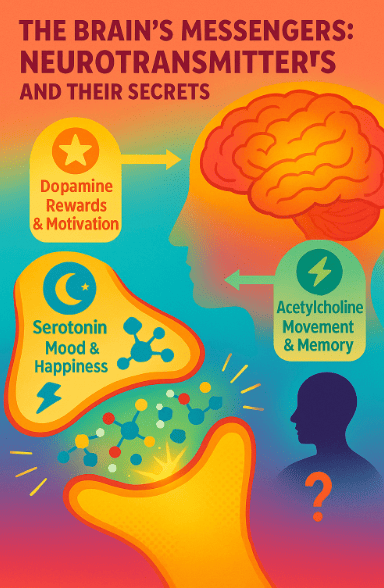
Quick Recap of Last Lesson
In the last lesson, we explored how neurons use electricity. We saw that neurons are like little batteries, charged at -70 millivolts, and that when sodium rushes in, an action potential fires down the axon like a spark. We also learned about myelin, the insulation that makes signals faster.
But here’s the problem: neurons don’t actually touch each other. They’re separated by a tiny gap.
So how does the electrical spark in one neuron become a message in the next? That’s where today’s lesson begins.
Step 1: The Mystery of the Tiny Gap – The Synapse 🌉
If you look closely under a microscope, you’d see that the axon terminals of one neuron don’t directly connect to the dendrites of the next. Instead, there’s a synaptic gap (synapse), a tiny space about 20–40 nanometers wide.
👉 A nanometer is one-billionth of a meter. If your fingernail grew one nanometer, you would not notice. That’s how small the synapse is.
So neurons need a way to jump this gap. Electricity alone can’t cross it. Instead, neurons release chemical messengers called neurotransmitters.
Step 2: Meet the Neurotransmitters – The Brain’s Mail System 📬
Think of neurotransmitters as little envelopes carrying messages across the synapse. When the action potential (the electrical spike) reaches the end of the axon:
-
Tiny bubbles called vesicles (little sacs made of fat) get the signal.
-
These vesicles merge with the edge of the neuron and release neurotransmitters into the gap.
-
The neurotransmitters float across the synapse and land on receptors on the next neuron’s dendrite.
-
If enough receptors are activated, the next neuron fires an action potential.
It’s like one person sending a letter, the post office delivering it, and another person reading it and responding.
Step 3: Different Kinds of Messages – Excitatory vs. Inhibitory 📢🤫
Not all neurotransmitters do the same job.
-
Some are excitatory: they encourage the next neuron to fire. Example: glutamate, the brain’s most common excitatory neurotransmitter.
-
Some are inhibitory: they tell the next neuron to stay quiet. Example: GABA (gamma-aminobutyric acid), which calms down brain activity.
This balance between “go” and “stop” signals keeps your brain stable. Too much excitation can cause seizures. Too much inhibition can cause drowsiness or even coma.
Step 4: Famous Neurotransmitters and Their Jobs 🌟
Let’s meet some of the most important neurotransmitters. Each one has its own “personality.”
-
Glutamate – The brain’s “on switch.” Helps with learning and memory.
-
GABA – The brain’s “off switch.” Calms activity, helps with sleep and relaxation.
-
Dopamine – The “reward” messenger. Involved in motivation, movement, and pleasure. Too little causes Parkinson’s disease; too much is linked with schizophrenia.
-
Serotonin – The “mood” messenger. Helps regulate happiness, sleep, and appetite. Many antidepressants boost serotonin.
-
Acetylcholine – The “connector” messenger. Helps muscles contract and is crucial for memory.
-
Norepinephrine (noradrenaline) – The “alert” messenger. Increases focus and prepares the body for action during stress.
-
Endorphins – The “painkiller” messengers. Released during exercise, laughter, or excitement to reduce pain and boost pleasure.
Each neurotransmitter is like a different kind of mail delivery: some are urgent letters, some are relaxing postcards, and some are emergency alerts.
Step 5: Recycling the Messages ♻️
After neurotransmitters deliver their message, what happens to them? They can’t just sit in the synapse, or they’d keep sending signals forever. The brain has cleanup systems:
-
Reuptake – The neuron sucks the neurotransmitter back inside for reuse (like recycling paper).
-
Enzyme breakdown – Special proteins break neurotransmitters apart into harmless pieces.
-
Diffusion – Some neurotransmitters simply drift away.
This recycling keeps brain communication precise and efficient.
Step 6: Drugs and Neurotransmitters 💊
Many drugs—both medicines and addictive substances—work by changing neurotransmitters.
-
Antidepressants (like SSRIs) block the reuptake of serotonin, making more available in the synapse.
-
Cocaine blocks dopamine reuptake, flooding the brain with “reward” signals.
-
Alcohol boosts GABA, making the brain calmer but also slower.
This is why understanding neurotransmitters is not just science—it’s essential for treating mental illness, addiction, and neurological diseases.
Step 7: The Symphony of the Brain 🎶
Imagine the brain as a giant orchestra. Neurons are the instruments, electricity is the rhythm, and neurotransmitters are the melodies.
Some instruments play loudly (excitatory), some softly (inhibitory), and together they create harmony.
Without neurotransmitters, the orchestra falls silent.
Without balance, the music becomes noise. With the right mix, the result is the masterpiece we call thought, feeling, and consciousness.
Final Recap 📝
In this lesson, we discovered that neurons don’t touch each other—they send messages across a tiny gap called the synapse.
The messengers that carry these signals are called neurotransmitters, and they come in many types: some excite, some calm, and each has a unique role.
After delivering their message, neurotransmitters are cleaned up through reuptake, breakdown, or diffusion. This chemical communication is the basis of mood, movement, memory, and even the effects of drugs.
In the next lesson, we’ll look at how the brain powers all this messaging—why it eats so much energy and how it fuels our thoughts. 🍞⚡